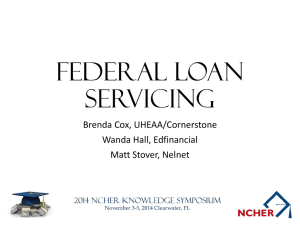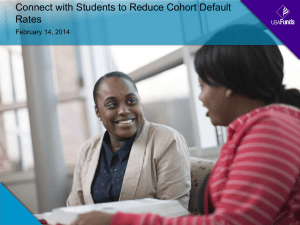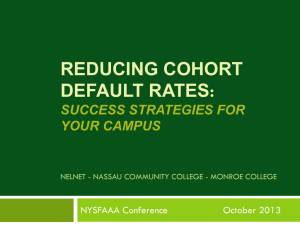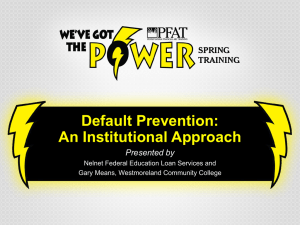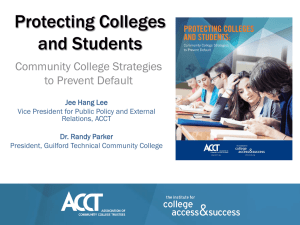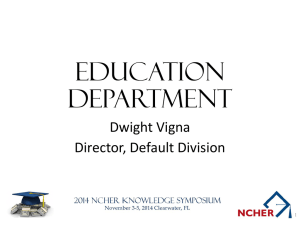monroe college – default prevention
advertisement
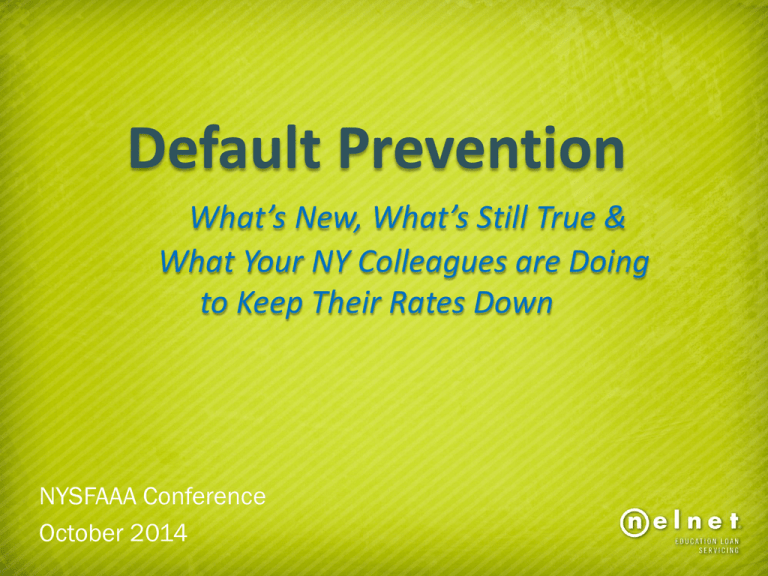
Default Prevention What’s New, What’s Still True & What Your NY Colleagues are Doing to Keep Their Rates Down NYSFAAA Conference October 2014 Cohort Default Rates Decrease OFFICIAL COHORT DEFAULT RATES PUBLIC PRIVATE PROPRIETARY NATIONAL AVERAGE FY 10 13% 8.2% 21.8% 14.7% FY 11 12.9% 7.2% 19.1% 13.7% The 3-Year Cohort Default Rate First year at 30% or more – Default prevention plan and task force – Submit plan to FSA for review Second consecutive year at 30% or more – Review/revise default prevention plan – Submit revised plan to FSA – FSA may require additional steps to promote student loan repayment Third consecutive year at 30% or more – Loss of eligibility: Pell, DL – School has appeal rights Your Current Active 3-year CDR Timeframes CDR Denominator: Enter Repayment Numerator: Default Publish Rates Cohorts used for Sanctions FY 2012 10/1/11-9/30/12 10/1/11-9/30/14 September 2015 FY 10, FY 11, FY 12 @ 30% FY 2013 10/1/12-9/30/13 10/1/12-9/30/15 September 2016 FY 11, FY 12, FY 13 @ 30% FY 2014 10/1/13-9/30/14 10/1/13-9/30/16 September 2017 FY12, FY 13, FY 14 @30% FY 2015 10/1/14-9/30/15 10/1/14-9/30/17 September 2018 FY13, FY14, FY15 @30% Did You Know? Of borrowers who defaulted, the majority withdrew without completing their academic programs. Borrowers who do not receive their full six-month grace period have a greater risk of defaulting. There is a strong correlation between increased financial literacy and decreased default risk. Source: Federal Student Aid 2012 Characteristics of Defaulters • Older (median age of 38 years old) • Pell recipient/low-income • Undergraduate loans only • Median loan balance: $5,800 • Poor financial literacy • Did not complete degree SOURCES: NSLDS, June 30, 2013; The Student Loan Default Trap: Why Borrowers Default and What Can Be Done About It, National Consumer Law Center, July 2012; What Matters in Student Loan Default: A Review of the Research Literature, Jacob P. K. Gross, Osman Cekic, Don Hossler, and Nick Hillman; Journal of Student Financial Aid, 2009; Calculating the Contribution of Demographic Differences to Default Rates, Mark Kantrowitz, May 2010. 7 Understand Who Is Defaulting at Your School and Why This will provide the right target population to focus on. (Photo credit: pixabay, public domain images) Nelnet Trends in Borrower Repayment Nelnet Trends in Borrower Repayment • Borrowers who get into a good early repayment habit are less likely to default. • Intervention efforts are more successful within the first 90 days of delinquency. From then on, there is a higher likelihood of eventual default. • Setting up auto-pay is a good determinant of repayment success, as well as signing up for an online account. Nelnet Trends in Borrower Repayment • Good contact information for a borrower is critical. Schools who collect updated contact information after entrance or exit are encouraged to share with servicers. • Students in skip-trace status are much more likely to default. • Much of the default or late delinquency groups are made up of borrowers with small balances. • Late Stage Delinquency – Borrowers in this category are very difficult for servicers to reach since they have avoided contact from us for so long. Nelnet Trends in Borrower Repayment Many borrowers have a knowledge gap when they go into repayment. They are unaware of: • Who their servicer is • What a servicer does • That they have options in addition to the standard ten-year payment plan • What deferments/forbearances are • That servicers can assist them if they run into repayment difficulties Please help servicers convey these messages. Student Success Model What Prevents Student Success? o Finances/need o Poor study habits o Relationship issues o Under-prepared, basic skill needs o Physical & mental health challenges o Language barriers o Dependent-care o Transportation o Housing o Transition difficulties o Feel unwelcome, no “campus connection” o First generation, no role models or family support Identifying Students in Trouble • Does your school have an “early warning” system? – Take attendance? – Issue mid-term grades which provide clues as to whether or not student will persist? – Alerts from faculty members, student support staff: who has missed classes? failed tests? had adjustment challenges? • Don’t allow academic or social problems to become default risk Helping Students in Trouble • Reach out immediately • Help them remain in school • If they’ve already left, help them to return – May involve help to overcome obstacles • If they will not return, help them to understand their repayment obligations as some think they don’t owe anything because they left • Learn what you can about their experiences and use this information to help other students stay in school Default Prevention - Outreach Efforts Consider When It Makes Sense to Intervene • Borrower education about repayment • Financial literacy • Gain additional or updated contact information • Engage borrowers through social media for increased exposure Consider When It Makes Sense to Intervene • • • • • • • Use social media to promote good loan repayment Ask borrowers to contact you if they have questions Reiterate the importance of communicating with their servicer(s) Validate contact information Re-enrollment or transfer assistance Employment counseling and search assistance Job placement assistance Consider When It Makes Sense to Intervene • Contact borrowers in early-stage delinquency (30-90 days) directly • Contact those in late-stage delinquency (210+ days) o By phone, if possible o Review servicer information and urge servicer contact Borrower engagement is a key factor in successful default prevention! School – Servicer Partnership All servicers work to gather feedback and find ways to partner with schools on default prevention. Partner with the servicers! Source: 21 Federal Student Aid 2012 School Best Practices: Niagara County Community College Jim Trimboli Default Student loan default is an institutional problem not a financial aid problem. • All departments on campus must take a proactive role in preventing default. (including the President ,Vice Presidents, and Area Managers). • 3 leading factors of Default prevention are: • Retention • Financial Literacy • Student Social Economic Background Default Threat to Community Colleges • Not only are community college student borrowing more money, community colleges now have the largest twoyear default rates of any higher education sector according to recent U.S Department of Education study. • Three-year community college CDR was nearly 21 percent for FY 2010 cohort. • (Source NASFAA Reporter Brittany Hackett) How is NCCC Reducing it’s Default Rate? • Student loan clerk hired to work the NSLDS Delinquent Borrow report(phone and emails) • Partnership with Consumer Credit Counseling of New York (Only state accredited debt counseling agency) • Working with Nelnet (proactive approach) • Student engagement with financial literacy component (website, touch points for students, open houses, and orientations) • (NCCC’s default rate dropped almost 5% in the last two years just using these prevention methods) NCCC in 2012 • In 2012 NCCC’s 3 year default rate was 20.4% • In 2013 NCCC’s 3 year Default rate dropped to 19.5% • In 2014 NCCC’s 3 year Default rate fell again to 15.6 % Important to note that NCCC is located between Buffalo and Niagara Falls, two of the poorest cities in America. SUNY SMART TRACK &NCCC • NCCC is the first pilot community college In the SUNY’s SMART TRACK Default Prevention Program. • SMART Track involves using NSLDS reporting data to extract student loan borrower information to establish a proactive communication platform to prevent student loan default and promote financial literacy. School Best Practices: Monroe College Clemente LaPietra MONROE COLLEGE – DEFAULT PREVENTION Default prevention is a college-wide effort that enjoys support of senior management. The Office of Loan Management – OLM entrusted with the task of working directly with students in this regard. OLM collaborates with other departments on ongoing basis to maximize outcomes. Borrowers separated into roughly four categories to determine the level and nature of counseling to be provided to them: 1. 2. 3. 4. Potential students: transfer or re-admitting students Enrolled students Students in their grace period Students with loans in repayment MONROE COLLEGE – DEFAULT PREVENTION 1. POTENTIAL STUDENTS/RE-ADMITS • Potential students with high loan balances referred to OLM for evaluation and counseling. • Re-admitted student borrowers also directed to meet with OLM staff to ensure prior loans are in good standing. Immediate assistance provided to address delinquencies. • This presents an opportunity to reiterate rights and responsibilities of borrowers and to caution against over-borrowing. MONROE COLLEGE – DEFAULT PREVENTION 3. STUDENTS IN THEIR GRACE PERIOD • Letters • E-mails 4. REPAYMENT a. Early Stage delinquency b. Late Stage delinquency Both stages are given the same attention except in the wording of the messages communicated to them. They constitute bulk of OLM’s work. MONROE COLLEGE – DEFAULT PREVENTION 2. ENROLLED STUDENTS • Entrance counseling. • Financial Literacy – DR_091 and classroom presentations. • DREAM initiative – iGrad on the college’s web site. • Exit counseling – one to one counseling encouraged when students withdraw or graduate. Online registration with servicers stressed, as is need to make the first payment or contact OLM if unable to make monthly payments. MONROE COLLEGE – DEFAULT PREVENTION Methods used • Letters – monthly or as needed. • E-mails – monthly or as needed. • Calls – daily (3-way with servicer when student answers). • Non-punitive restriction on delinquent students’ accounts to alert other departments to send them to OLM. MONROE COLLEGE – DEFAULT PREVENTION RESOURCES USED • Students’ financial aid records. • In-house networking – Office of Career Advancement database. – Student Services Department. • Default prevention software. • Servicers – Reports and information on borrower activities. MONROE COLLEGE – DEFAULT PREVENTION RESOURCES – contd. • NSLDS a. School Portfolio Report - #20 SCHPR1. b. Exit completion Report (new - excel format): To view immediately select Output Medium: XLS. Report Tab, Select Web Report List ; Report #3 EXTC01. Review Limited Resources/Best Results Identify Cohorts in effect Work with Servicers o Pull delinquency reports by cohort year Identify highest risk (most delinquent) Develop plan for contact o Phone most effective o Email, Letters, Text messages if can’t reach by phone o Integrate effort with other campus offices with whom student has relationship Limited Resources/Best Results Use school d-base for contact info o When student in school, update contact info, references, personal email/facebook accounts, obtain authorization to text, etc. When contacting borrower, have portfolio of loan history o Recommendations depend on characteristics of loan o Make warm transfer to Servicer while student on phone Limited Resources/Best Results Students who withdraw are at **HIGH RISK** Official Withdraw - Required to meet with FA SAP, Academic Dismissals - Track, monitor separately Unofficial Withdrawals o Receive info from academic offices, registrar others o Report to NSLDS/Clearinghouse immediately o Reach out to students by mail, phone informing them of obligation re. student loan o Update contact info, address, references, emails, etc. so you can contact in future Resources Cohort Default Rate Guide The “Cohort Default Rate Guide” (Guide) is a publication that the U.S. Department of Education designed to assist schools with their 2-Year and 3Year FFEL Program and Direct Loan Program CDR data. The guide has been updated and should be used as a reference tool in understanding CDRs and processes. Source: Federal Student Aid 2012 Financial Awareness Counseling Tool- FACT Each module has been designed to communicate key financial management concepts to increase students’ financial literacy. Understand Your Loans Your Student Loans Loan Basics Free Money First Types of Student Loans Manage Your Spending Manage Your Spending While In School Live Within Your Means Borrow Smart Source: Federal Student Aid 2012 Plan to Repay Estimate What You Will Owe, Spend & Earn • Monthly Expenses • Monthly Income Understand Repayment Avoid Default Avoiding Default Postpone or Lower Your Payments Forgive or Cancel Your Debts Delinquency and Default Make Finances a Priority Plan For the Future Your Income and Taxes Your Credit and Identity Credit Cards and Other Borrowing Default Prevention Page Thank You! Jim Trimboli, Director of Financial Aid Niagara County Community College jtrimboli@niagaracc.suny.edu Clemente LaPietra, Monroe College clapietra@monroecollege.edu Anne Del Plato, Regional Director of Partner Solutions Nelnet Education Loan Servicing anne.delplato@nelnet.net


